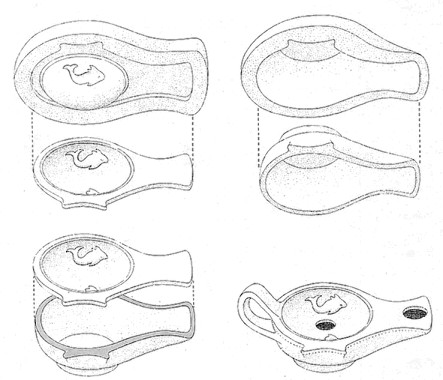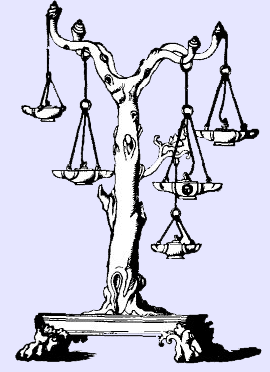.
Pythias once, scoffing at Demosthenes, said that his arguments smelt of the lamp. Plutarch, Life of Demosthenes.

Joseph-Benoit Suvee, Invention of the Art of Drawing, 1791, 2.67 m x 1.32 m, Groeninge Museum, Bruges
According to a legend the first figurine in clay was produced by Boutades, a Sikyonian potter at Corinth thought to have lived before 657 BC. Boutades produced the figurine on behalf of his daughter, "who was in love with a young man; and she, when he was going abroad, drew in outline on the wall the shadow of his face thrown by a lamp. Her father, having pressed clay onto this, made a relief that he hardened by exposing it to fire along with the rest of his pottery" Pliny. The daughter of Boutades sketched the outline of a boy’s shadow, cast on the wall by lamplight as he slept. Delighted with the perfection of the likeness, Boutades cut out the shape, filled in the outline with clay and made a model that he dried and baked (Pliny 35. 151-152 and Athenagoras, Legatio pro Christianis 17). Antonio Corso The Position of Portraiture in Early Hellenistic Art Criticism
It was around the late 60s when one day I was present when a technician connected my grandmother's house with the electricity network and electric light was available for the first time in 2 rooms of her house. Before she used 2 oil lamps. For around 10 years I spent my holidays in her house. It took 36 hours to travel the distance between Stuttgart Germany and Xanthi Greece using a train and bus Very few used an airplane. I remember how magical was the light of the oil lamp that was good enough to read a book if the lamp was close enough. I remember that ironically one of the books I had with me was a German book about the technology of the future and one chapter was about cold electric light. It took many decades until Edison's invention was also available in the small village Magiko in Xanthi Greece.
Oil Lamps have been found in a settlement at Zagora, Andros, (eighth-century BC). They were used earlier (described also by Homer) as Minoan lamps were found in Crete. Around 700 BC Greeks began making terra cotta lamps replacing torches.
The word lamp is derived from the Greek word lampas, meaning torch.

A lamp could be used for about three hours.
Around 300 BC a method was discovered to produce a large number of lamps. Instead of the lamps which had to be formed by hand, matrices were used. In two parts these forms were filled and the two pieces were joined together. This reduced the price of the lamps significantly. For many years they were exported and used for example by the Romans.

Matrix forms for the production of two pieces of a lamp.
The lamps later were also produce by the Romans and exported. An early sign of “Globalization”. By the beginning of the 5th century BC pottery-making in Greece was a mass-production business with a pottery-owner employing many workmen. Workers were specialized. Each clay worker had a specific area of work; be it digging or refining clay. For potters there were more skilled jobs concerned with throwing, moulding, decorating and firing pottery. A large spectrum of pottery was produced in large numbers. The main production sites were Corinth and Athens. The mass produced Pottery is of low quality but it was found in Spain and in Ukraine showing the range of trade. Petroleum was very rare in Antiquity, so the oils used for lamps were vegetable oils. Burning olive oil smells (commonly described in ancient literature as "smelling of the lamp”).
Lychnopolae: Lampdealers, people who sell lamps

Bronze lampholder from Pompeii: Five lamps hung from the branches of this bronze tree.
Festival of the Lamps Egypt and Herodotus
A History of Light and Lighting
RECYCLING MISFIRED POTTERY. A standard practice of the potters at ancient Sagalassos ?
Perseus Images
Ancient Lamps. from Knight's Mechanical Encyclopedia (ed. Knight) , Text for the images
A brief history of oil lamps
A History of the Cone Lamp
Oil Lamps in American History
Greek and Roman Pottery Lamps, by Donald M. Bailey, The British Museum, 1972
| Ancient Greece
Science, Technology , Medicine , Warfare, , Biographies , Life , Cities/Places/Maps , Arts , Literature , Philosophy ,Olympics, Mythology , History , Images Medieval Greece / Byzantine Empire Science, Technology, Arts, , Warfare , Literature, Biographies, Icons, History Modern Greece Cities, Islands, Regions, Fauna/Flora ,Biographies , History , Warfare, Science/Technology, Literature, Music , Arts , Film/Actors , Sport , Fashion --- |

